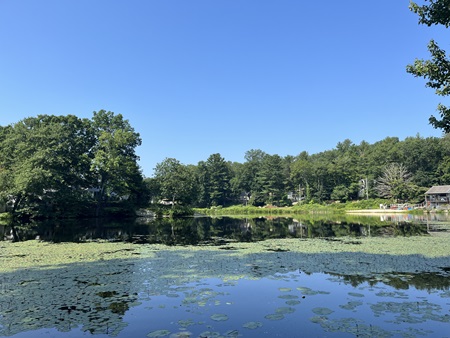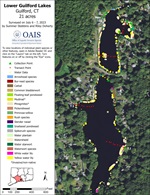
Lower Guilford Lakes, Guilford - 2023
Lower Guilford Lakes, locally referred to as Lower/First Lake and Middle/Second Lake, are connected by a fairly large opening below the North Madison Rd bridge. The lakes are 20 acres in total and have two small beach areas, one on each lake. Residential homes are found around the entire shoreline and the Guilford Lakes Golf Club is close by. Between 1990 and 1994, the lakes were dredged to prevent nuisance growth of aquatic plants. The deepest part of the lake is 7m or about 23 ft.
Lower Guilford Lakes was surveyed on July 6 - 7, 2023. Due to the water’s brown coloration, the water clarity (measured with a Secchi disk) was 1.2m or about 4ft. There were 17 aquatic plant species and 2 wetland species present. The wetland species include native cattail and invasive phragmites. Both cattail and phragmites were documented in Lower Lake but not Middle Lake. Mudmat, a non-native aquatic plant species indigenous to New Zealand and Australia was found in both lakes. Although mudmat isn’t native, it is not considered invasive. In Connecticut, mudmat hasn’t exhibited harmful traits and is so tiny it is not at risk of becoming a nuisance.
There were 16 native aquatic plant species documented in Lower Guilford Lakes, a moderately diverse plant community. All but two aquatic plant species were documented in both Middle and Lower Lake. The two species found in Middle but not Lower Lake include floating-leaf pondweed and rush. Watershield and yellow water lily were the most common aquatic plant species in both lakes. Aquatic plants grow throughout most of the shoreline or littoral area of Middle Lake, less so in Lower Lake. The eastern cove of Middle Lake has more aquatic plant coverage, likely because it is shallower.
|
Species recorded in the 2023 survey of Lower Guilford Lakes. |
||
| Arrowhead species |
Pickerelweed |
Watershield |
| Bur-reed species |
Primrose-willow |
Water starwort |
| Cattail |
Rush species |
Waterwort species |
| Slender naiad |
White water lily |
|
| Snailseed pondweed |
Yellow water lily |
|
| Mudmat* | Spikerush species |
|
| Phragmites* | Water plantain |
|


